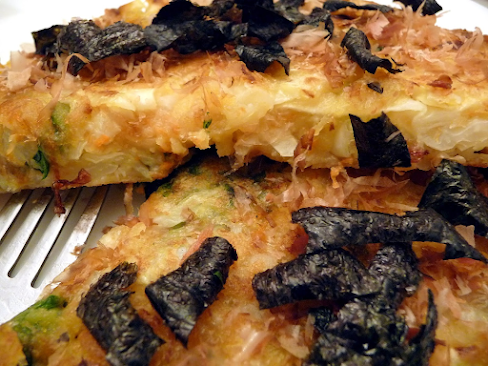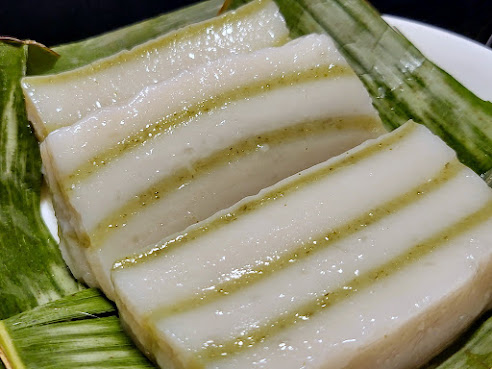Okonomiyaki Part 1 Of 2
お好み焼き
Okonomiyaki お好み焼き
Okonomiyaki (Japanese: お好み焼き) is a Japanese teppanyaki, savory pancake dish consisting of wheat flour batter and other ingredients (mixed, or as toppings) cooked on a teppan (flat griddle). Common additions include cabbage, meat, and seafood, and toppings include okonomiyaki sauce (made with Worcestershire sauce), aonori (dried seaweed flakes), katsuobushi (bonito flakes), Japanese mayonnaise, and pickled ginger.
Okonomiyaki is mainly associated with two distinct variants from Hiroshima or the Kansai region of Japan, but is widely available throughout the country, with toppings and batters varying by area. The name is derived from the word okonomi, meaning "how you like" or "what you like", and yaki, meaning "grilled". It is an example of konamono (konamon in the Kansai dialect), or flour-based Japanese cuisine.
It is also called by an abbreviated name, "okono", where the O is a politeness prefix and kono means ‘favorite’.
A liquid-based okonomiyaki, popular in Tokyo, is called monjayaki (also written as monja yaki) and abbreviated as "monja".
Okonomiyaki is mainly associated with two distinct variants from Hiroshima or the Kansai region of Japan, but is widely available throughout the country, with toppings and batters varying by area. The name is derived from the word okonomi, meaning "how you like" or "what you like", and yaki, meaning "grilled". It is an example of konamono (konamon in the Kansai dialect), or flour-based Japanese cuisine.
It is also called by an abbreviated name, "okono", where the O is a politeness prefix and kono means ‘favorite’.
A liquid-based okonomiyaki, popular in Tokyo, is called monjayaki (also written as monja yaki) and abbreviated as "monja".
For Kansai-style okonomiyaki, ingredients are mixed into a flour batter and then cooked as a single-layered pancake. In contrast, the Hiroshima-style layers its ingredients, beginning with a thin fried egg and crepe-like batter followed by vegetables, meat and stir-fried noodles.
2 Episodes exploring:
Part 1: Kansai style okonomiyaki, Hiroshima-style okonomiyaki, Monjayaki;
Part 2: Kaki-oko, Kashiminyaki, Modanyaki
▲ 1. Kansai style Okonomiyaki (Osaka-yaki)
関西風お好み焼き
Kansai style Okonomiyaki (Osaka style Okonomiyaki), assorted grill or random grill, is a teppanyaki snack originating from Japan. The method of making is to add water to wheat flour and stir to form a batter, add vegetables, meat, fish and shellfish and other materials, fry them on an iron plate, and finally add seasonings to eat.
The taste and texture of the pancakes are very good. The outer layer is crispy while the inside is still moist and chewy, and the secret okonomiyaki sauce (pancake sauce) is a must.
This time, I prepared kabocha soup, mixed with cake flour and Nagaimo to form the batter. Fillings were shirauo (Salanx chinensis), eggs, cabbage, carrots, green onions and parsley. Toppings were Katsuobushi, seaweeds and Okonomiyaki sauce. The taste and texture of this pancake were excellent. The exterior was crispy while inside was wet and chewy. Okonomiyaki sauce was yummy.
Ingredients
Batter: Cake Flour, kabocha soup, Nagaimo, water
Fillings: shirauo (Salanx chinensis), eggs, cabbage, carrots, green onions, parsley
Garnish: Katsuobushi, seaweeds
Okonomiyaki sauce: Kikkoman Soy Sauce, sake, mirin, kabocha soup, garlic, ginger, bay leaves, Lea & Perrins Worcestershire sauce
▲ 2. Hiroshima style Okonomiyaki (Hiroshima-yaki).
広島風お好み焼き
Hiroshima-yaki is "fired without mixing ingredients with batter", while Osaka-yaki is fired by mixing ingredients and batter together, and this is the biggest difference between the two. The correct way to cook Hiroshima-yaki is to burn the batter into the thinnest bread possible, and then layer the ingredients on top of each other, which is the style of Hiroshima-yaki. Hiroshima-yaki's pancakes are self-contained, with layered ingredients, including shallots, beef shank, eggs, cabbage, and bean sprouts on the pancake. Yakisoba noodles and secret okonomiyaki sauce (pancake sauce) on the bottom.
Ingredients
Batter: Cake Flour, kabocha soup, Nagaimo, water
Toppings: green onions, beef shank, eggs, cabbage, bean sprouts
Bottom: Yakisoba noodles
Garnish: Carrots thin slices, seaweeds
Okonomiyaki sauce: Kikkoman Soy Sauce, sake, mirin, kabocha soup, garlic, ginger, bay leaves, Lea & Perrins Worcestershire sauce
▲ 3. Monjayaki (Tokyo-yaki)
もんじゃ焼き
Monjayaki is a Japanese pancake that originates from Tsukishima Island in Chuo-ku, Tokyo, Japan, and is popular in the Kanto region of Tokyo. There are more than 70 Monja specialty shops in Tsukishima, Tokyo, which is known as the "Monja Street", so you can try it when you visit Tokyo, Japan! In the Edo period, many people baked ingredients on an iron plate in the shape of characters, so it was called Monjayaki. The way of eating Monjayaki is completely different from that of other okonomiyaki in that diners need to use a small spatula to pick up the fried Monjayaki on the teppanyaki and eat it, or you can put the batter on the teppanyaki and eat it until it is crispy, so that the texture becomes crispy. In addition, Monjayaki is best eating with sushi rice.
The way of preparing Monjayaki is different from Osaka-yaki and Hiroshima-yaki. First put the cake flour, Lea & Perrins Worcestershire sauce, dashi, and water into a large bowl and mix it into a thin batter, then add vegetables, meat, seafood and other ingredients to the large bowl and mix evenly, only pick up the ingredients and put them on the preheated iron plate, leaving the remaining thin batter in a large bowl for later use. Stir-fry with a pair of okonomiyaki shovels, and after the ingredients are overheated, form a circle in the center and pour the remaining thin batter into the hollow in the center. After the thin batter is boiled, stir it with the ingredients, spread it thinly on the iron plate, and when the ingredients are cooked, press the ingredients on the iron plate with a small spatula starting from the side part, and eat while letting the bottom of the ingredients burn fragrant. The batter of monjayaki is a little different from other okonomiyaki in that it is thinner because of the addition of dashi, and when cooked, it looks like melted cottage cheese. It is worth mentioning that the top of the monja is very moist and sticky, and it does not have the shape of a "cake" like Osaka-yaki and Hiroshima-yaki, but there is a layer of crispy rice at the bottom of the monjayaki, and the texture of the two layers overlapping is very novel and delicious!
The way of preparing Monjayaki is different from Osaka-yaki and Hiroshima-yaki. First put the cake flour, Lea & Perrins Worcestershire sauce, dashi, and water into a large bowl and mix it into a thin batter, then add vegetables, meat, seafood and other ingredients to the large bowl and mix evenly, only pick up the ingredients and put them on the preheated iron plate, leaving the remaining thin batter in a large bowl for later use. Stir-fry with a pair of okonomiyaki shovels, and after the ingredients are overheated, form a circle in the center and pour the remaining thin batter into the hollow in the center. After the thin batter is boiled, stir it with the ingredients, spread it thinly on the iron plate, and when the ingredients are cooked, press the ingredients on the iron plate with a small spatula starting from the side part, and eat while letting the bottom of the ingredients burn fragrant. The batter of monjayaki is a little different from other okonomiyaki in that it is thinner because of the addition of dashi, and when cooked, it looks like melted cottage cheese. It is worth mentioning that the top of the monja is very moist and sticky, and it does not have the shape of a "cake" like Osaka-yaki and Hiroshima-yaki, but there is a layer of crispy rice at the bottom of the monjayaki, and the texture of the two layers overlapping is very novel and delicious!
Ingredients
Batter: Cake Flour, Lea & Perrins Worcestershire sauce, dashi soup, water
Fillings: cuttlefish, shrimp, mussels, cabbage, bonito flakes, seaweed
kabocha soup, Nagaimo, water
Toppings: green onions, beef shank, eggs, cabbage, bean sprouts
Bottom: Yakisoba noodles
Garnish: Carrots thin slices, seaweeds
Secret Okonomiyaki sauce: Kikkoman Soy Sauce, sake, mirin, dashi soup, garlic, ginger, bay leaves
Next, Okonomiyaki Part 2 Of 2,
Japanese teppanyaki, savory pancake
Publisher: Chef Kar Delight






































